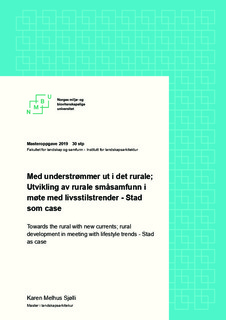| dc.contributor.advisor | Clemetsen, Morten | |
| dc.contributor.author | Sjølli, Karen Melhus | |
| dc.coverage.spatial | Norway, Sogn og Fjordane, Selje, Stadlandet | nb_NO |
| dc.date.accessioned | 2019-09-04T12:17:17Z | |
| dc.date.available | 2019-09-04T12:17:17Z | |
| dc.date.issued | 2019 | |
| dc.identifier.uri | http://hdl.handle.net/11250/2612496 | |
| dc.description.abstract | Den ledende demografiske trenden i Norge i dag, er urbanisering og sentralisering. Etterhvert som samfunnet har blitt mer industrialisert og effektivisert, er færre knyttet til ressursgrunnlaget i primærnæringen, noe som er med på å utarme lokalsamfunn.
Samtidig som vi har fått et postindustrielt, kapitalistisk forbrukersamfunn som oppfordrer til tidseffektivitet og økt vekst, oppleves flere et skifte i meningsinnhold og verdier. Mange har et ønske om en livsstil med mer selvutfoldelse, både gjennom jobb og fritid i attraktive omgivelser. Denne privilegerte formen for bostedsvalg er muliggjort av megatrender innenfor økonomi, mobilitet og teknologi. De samme kreftene som har ført oss bort fra grunnleggende verdier som tid, nærhet og tilhørighet, har paradoksalt nok ført til en ny understrøm tilbake til bygdene.
Hvordan livsstilstrender kan påvirke rurale småsamfunn som ellers er truet av fraflytting, er et lite utforsket fenomen innenfor stedsutvikling. I oppgaven foreslås det et program for utvikling av rurale småsamfunn i møte med livsstilstrender, delt inn i generell og stedsspesifikke mål og prinsipper. Programmet er basert på litteratur- og teoristudie knyttet til stedsidentitet, tilknytning og tilhørighet, midlertidighet og flyktighet, trender og livsstilstrender, rural stedsutvikling, samt hvordan man kan forhandle om et felles narrativ på tvers av grupper, og forankre livsstilsflytterne i et lokalsamfunn. Dette oversettes til prinsipper og tiltak i den stedlige konteksten Stadlandet i Selje kommune, på bakgrunn av overordnet landskapsanalyse, stadkjensle- og sosiokulterelle analyser. Målet med programmet er å skape, utløse eller å forsterke synergier, forbindelser og verdier mellom grupper og landskap, og å skape attraktive og inkluderende omgivelser, for både tilflyttere og lokalsamfunn. | nb_NO |
| dc.description.abstract | The leading demographic trend in Norway is urbanization and centralization. As society has become more industrialized and made more efficient, fewer are attached to the resource-foundation of the primary industry, which in turn is leading to the impoverishment of local communities. At the same time as we have experienced a post-industrial, capitalistic, consumer society, that promotes efficiency in time and increased growth, more are experiencing a shift in their convictions and values. Many wishes for a way of life where self-realization, and to have an inventive approach to their surroundings, are essential components.
Lifestyle migrants and the resources and values they are often associated with, frequently fall outside of the typical surveys and research that investigate reasons for moving. These surveys are often centred on people moving back to their place of origin. How life style migrants can shape villages which are otherwise threatened by abandonment, is a rarely studied phenomenon. This thesis will therefore investigate how one can create development in rural, small-case communities, in relation to lifestyle trends with the case of Stadlandet in the municipality of Selje.
This thesis suggests a programme for developing rural, small communities in their meeting with lifestyle trends, divided into one general part with goals and principles, and one place-specific parts that translates the principles to design in local context, rooted in empirical knowledge. The programme is based on studies of literature and theory connected to place identity; attachment and belonging; fluid modernity and rootlesness, trends and lifestyle trends; lifestyle migrants; rural place development, as well as how one can negotiate a shared narrative across different groups in a local community, and anchor the lifestyle migrant into a the local community. Further, this is translated and suggested as design in alocal context, on the background of a landscape analysis, and in sense of place and sociocultural analyses. The aim with the programme is to create, and to release or strengthen synergies, connections, and values between groups and landscapes in a sustainable perspective, and to create attractive and including surroundings and communities for both newcomers and the respective local communities. | nb_NO |
| dc.language.iso | nob | nb_NO |
| dc.publisher | Norwegian University of Life Sciences, Ås | nb_NO |
| dc.rights | Attribution-NonCommercial-NoDerivatives 4.0 Internasjonal | * |
| dc.rights.uri | http://creativecommons.org/licenses/by-nc-nd/4.0/deed.no | * |
| dc.subject | Stedsutvikling | nb_NO |
| dc.subject | Rural utvikling | nb_NO |
| dc.subject | Verdiskaping | nb_NO |
| dc.title | Med understrømmer ut i det rurale : utvikling av rurale småsamfunn i møte med livsstilstrender : Stad som case | nb_NO |
| dc.title.alternative | Towards the rural with new currents : rural development in meeting with lifestyle trends : Stad as case | nb_NO |
| dc.type | Master thesis | nb_NO |
| dc.source.pagenumber | 109 | nb_NO |
| dc.description.localcode | M-LA | nb_NO |

